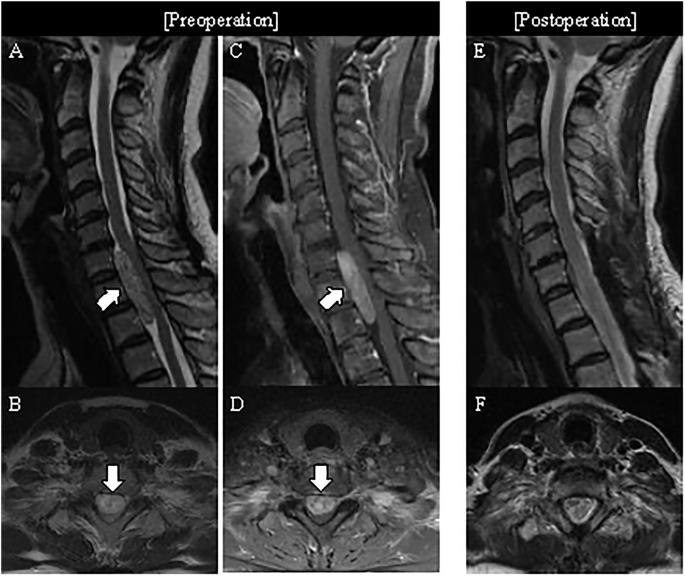腹侧与背侧/外侧硬膜内髓外神经鞘瘤的手术和临床结果:一项回顾性比较研究。
IF 2.2
4区 医学
Q3 CLINICAL NEUROLOGY
引用次数: 0
摘要
研究设计:回顾性比较研究。目的:比较腹侧硬膜内髓外(IDEM)神经鞘瘤与背侧/外侧IDEM神经鞘瘤的手术和临床结果。背景:日本唯一的机构。方法:本研究纳入了94例2012年至2022年间经后路手术切除的颈椎或胸椎IDEM神经鞘瘤患者。根据肿瘤定位将患者分为腹侧组(n = 12)和背侧组(n = 82)。评估人口统计学和外科数据,包括手术时间和术中运动诱发电位(MEP)变化,以及临床结果,如日本骨科协会(JOA)评分和步态功能(改良McCormick量表,MMCS)。结果:与背侧组相比,腹侧组手术时间明显更长(p = 0.039),术中MEP波形更有可能短暂下降(p = 0.008)。然而,在手术年龄、性别、水平、肿瘤大小、估计失血量、JOA评分改善、JOA恢复率或最终随访时的步态功能方面,两组之间没有显著差异。所有病例均获得全切除(GTR)。结论:尽管手术时间更长,术中MEP波形更有可能暂时下降,但与背侧/外侧IDEM神经鞘瘤相比,腹侧IDEM神经鞘瘤的手术或临床结果并不明显差。这些发现表明,即使手术过程需要更长的时间,经后路大体切除腹侧神经鞘瘤也会产生良好的治疗效果。本文章由计算机程序翻译,如有差异,请以英文原文为准。

Surgical and clinical outcomes of ventral versus dorsal/lateral intradural extramedullary schwannomas: a retrospective comparative study
Retrospective comparative study. To compare the surgical and clinical outcomes of ventral intradural extramedullary (IDEM) schwannomas to those of dorsal/lateral IDEM schwannomas. The single institution in Japan. This study included 94 patients with cervical or thoracic IDEM schwannomas who underwent tumor resection via a posterior approach between 2012 and 2022. Patients were categorized into Ventral (n = 12) and Dorsal/Lateral (n = 82) groups based on tumor localization. Demographic and surgical data, including surgical time and intraoperative motor evoked potential (MEP) changes, as well as clinical outcomes such as Japanese Orthopaedic Association (JOA) scores and gait function (modified McCormick scale, MMCS), were evaluated. The Ventral group had a significantly longer surgical time (p = 0.039) and was more likely to experience a temporary decrease in intraoperative MEP waveforms (p = 0.008) compared to the Dorsal/Lateral group. However, there were no significant differences between the groups in age at surgery, sex, level, tumor size, estimated blood loss, JOA score improvement, JOA recovery rate, or gait function at the final follow-up. Gross total resection (GTR) was achieved in all cases. Despite longer surgical times and more likely to experience a temporary decrease in intraoperative MEP waveforms, ventral IDEM schwannomas do not result in significantly worse surgical or clinical outcomes compared to dorsal/lateral IDEM schwannomas. These findings suggest that even if the surgical procedure requires longer, gross total resection of ventral schwannomas via a posterior approach is resulting in favorable treatment outcomes.
求助全文
通过发布文献求助,成功后即可免费获取论文全文。
去求助
来源期刊

Spinal cord
医学-临床神经学
CiteScore
4.50
自引率
9.10%
发文量
142
审稿时长
2 months
期刊介绍:
Spinal Cord is a specialised, international journal that has been publishing spinal cord related manuscripts since 1963. It appears monthly, online and in print, and accepts contributions on spinal cord anatomy, physiology, management of injury and disease, and the quality of life and life circumstances of people with a spinal cord injury. Spinal Cord is multi-disciplinary and publishes contributions across the entire spectrum of research ranging from basic science to applied clinical research. It focuses on high quality original research, systematic reviews and narrative reviews.
Spinal Cord''s sister journal Spinal Cord Series and Cases: Clinical Management in Spinal Cord Disorders publishes high quality case reports, small case series, pilot and retrospective studies perspectives, Pulse survey articles, Point-couterpoint articles, correspondences and book reviews. It specialises in material that addresses all aspects of life for persons with spinal cord injuries or disorders. For more information, please see the aims and scope of Spinal Cord Series and Cases.
 求助内容:
求助内容: 应助结果提醒方式:
应助结果提醒方式:


